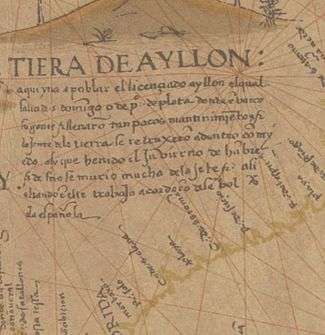Lucas Vázquez de Ayllón
| Lucas Vázquez de Ayllón | |
|---|---|
| Died |
18 October 1526 |
Lucas Vázquez de Ayllón (Spanish pronunciation: [ˈlukas ˈβaθkeθ ðe aiˈʝon]; c. 1478, probably Castile, Spain – 18 October 1526) was a Spanish explorer who in 1526 established the short-lived San Miguel de Guadalupe colony, the first European attempt at a settlement in what is now the continental United States. Ayllón's account of the region inspired a number of later attempts by the Spanish and French governments to colonize the southeastern United States.
Life
Ayllón arrived at Santo Domingo in April 1502, with Nicolás de Ovando y Cáceres's flotilla. Under Ovando, Ayllón was appointed alcalde (mayor) of Concepcion. Ayllón left the island in 1509, returning to Spain where he earned a law degree from Valladolid. He went back to Santo Domingo after his appointment as a judge (oidor) of the Royal Audiencia, representing the Spanish Crown.[1]
.jpeg)
A licentiate and sugar planter on Hispaniola, Ayllón organized a settlement expedition to the mainland of North America in 1526. He commanded six vessels with 600 colonists, supplies, and livestock, sailing from Santo Domingo in mid-July 1526. The large colonizing group landed in Winyah Bay, near present-day Georgetown, South Carolina, on September 29, 1526, the Feast of Archangels day.
They looked for an area suitable for colonization approximately 15 km north, near Pawleys Island. They found the area unsuitable, and Ayllón decided to move further south. Some accounts say that some settlers took an overland voyage, while others left on a new boat built at the temporary settlement. If true, this would probably have been the earliest example of European-style boat building in what is now the United States. Heading southward, likely by both land and sea, the group reunited. On October 8, 1526, they established the short-lived colony of San Miguel de Guadalupe, the first European settlement in the present United States, probably at or near present-day Georgia's Sapelo Sound.[2]

Ayllón had received from Charles V in 1523 a grant for the land explored in 1521 by Francisco Gordillo and slave trader Captain Pedro de Quejo (de Quexo).[3][4] On the 1521 expedition, Gordillo and de Quejo had kidnapped about 70 natives, including one baptized with the name Francisco de Chicora. Gordillo took the young captive to Hispaniola, where he learned Spanish and converted to Catholicism, becoming a favorite of Ayllón, who carried Chicora with him to Spain. There they met the court chronicler, Peter Martyr, with whom Chicora talked at length about his people and homeland, and about neighboring provinces.
In 1525 Ayllón sent Quejo northward and received reports of the coastline from as far north as the Delaware Bay.[5] In 1526, his new colony used African slave-labor, perhaps the first instance within the present territory of the United States. Ayllón died in the colony in 1526, purportedly in the arms of a Dominican friar.[6]
Ayllón's rough-hewn town survived only about a total of three months, enduring hunger, disease, scarcity of supplies, and troubles with the local natives. Of the colony of 600 people whom Ayllón had brought with him, only 150 survivors made their way back to Hispaniola that winter. Most scholars consider attempts to locate the San Miguel settlement (Tierra de Ayllón) any farther north, even as far north as the Chesapeake Bay, to be unsubstantiated conjecture.[7]
Ayllón and his settlers lost one of their ships near the mouth of Winyah Bay. State archaeologists are working to locate the site of the wreck. Ayllón's colony was the first European colony in what is now the United States, preceding St. Augustine, Florida (the first successful colony) by 39 years, the Roanoke Colony by 61 years, and Jamestown, Virginia by 81 years.
See also
Notes
- ↑ Floyd, Troy (1973). The Columbus Dynasty in the Caribbean, 1492-1526. Albuquerque: University of New Mexico Press. pp. 53, 68, 138, 144.
- ↑ David J. Weber (14 May 2014). The Spanish Frontier in North America. Yale University Press. p. 31. ISBN 978-0-300-15621-8.
- ↑ Paul E. Hoffman (1994). "Lucas Vázquez de Ayllón's Dixcovery and Colony". In Charles M. Hudson, Carmen Chaves Tesser. The Forgotten Centuries: Indians and Europeans in the American South, 1521-1704. University of Georgia Press. p. 36. ISBN 978-0-8203-1654-3.
- ↑ Paul E. Hoffman (April 1980). "A New Voyage of North American Discovery: Pedro de Salazar's Visit to the "Island of Giants"". The Florida Historical Quarterly. Florida Historical Society. 58 (4): 421. doi:10.2307/30140493.
- ↑ "Francisco Gordillo and Pedro de Quejo". Retrieved 2008-12-29.
- ↑ Margaret F. Pickett; Dwayne W. Pickett (15 February 2011). The European Struggle to Settle North America: Colonizing Attempts by England, France and Spain, 1521-1608. McFarland. p. 26. ISBN 978-0-7864-5932-2. Retrieved 28 May 2012.
- ↑ Paul E. Hoffman (15 December 2015). A New Andalucia and a Way to the Orient: The American Southeast During the Sixteenth Century. LSU Press. p. 328. ISBN 978-0-8071-6474-7.
References
| Library resources about Lucas Vázquez de Ayllón |


